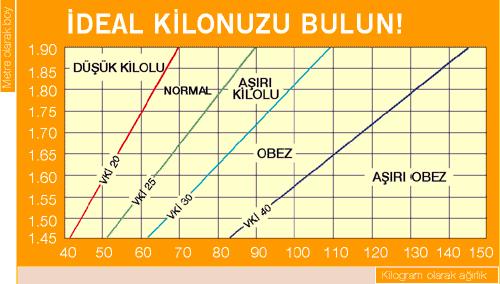How many centimeters is around your waist?
If you have excess fat around you at your abdomen and if your waist size is high, your risk is high for coronary artery disease, high blood pressure, stroke, diabetes and various cancer types. If you want to well monitor your health, you should not forget to measure around your waist.
Your waist says:
Measure around your waist once an every six months to define whether you carry excess fat at your abdominal region. Find the highest point at each thighbone and perform the measurement over this region.

Measures over 102 cm at males and 88 cm at females indicates increasing health risks. You have more risk if your Body Mass Index is higher than 25. Don't forget that the more your waist size and body mass index, the higher risk for you.
Why am i gaining weight?
a) Food calorie > Calorie consumption = Weight gain
b) Food calorie < Calorie consumption = Weight loss
c) Food calorie = Calorie consumption = Staying at same weight
How much body fat you have?
The amount of accumulated fat at the abdominal region has more risk compared to other fats accumulated superficially at any part of the body. These fats accumulate around of organs, back of the abdomen and around the kidney or under the skin. We know that particularly the last two parts produce an important health risk.
Your weight is measured at the gym evaluations. When you get on the scale, your bones, organs, blood, fat at your body, muscles and other tissues are weighted. This weight may be misleading. Because the muscles are heavier than the fat. To be weak is not always to be healthy. A person may have thin bone structure and less muscle structure. Essentially important thing is how much fat does include this weight. Cardiovascular diseases, diabetes and some types of cancer are more common in obese people, that is men with more than 20% fat and more than 30% women. However, these health problems are not completely results from the excess fat. They may be due to lack of exercise and poor nutrition.
Body mass index or waist circumference?
There is not only fat tissue in your body. There are also different tissues such as muscle tissues and bone tissues. Many calculations have been proposed to evaluate the obesity. The calculation with the most consensus on it is the body mass index. Body mass index is the most reliable measure to define the increase at body fat mass independent from muscle and bone mass. You measure your weight in kilogram and height in centimeters and divide your weight to square of your height in meters. For example, if you are 80 kg weight and 1.60 height, you can find your body mass index by dividing 80 to square of 1.6
BMI = a / b2
a = Body weight (kg)
b = Height (meter)
Defining of the excess weight and obesity level is performed according to body mass index. However, body mass index can lead to some persons to be included to over weighted category by mistake due to body muscle rate differences. In particular, particular people with very short height may be evaluated as over weighted by mistake in body mass index calculation.

Body mass index is a simple, fast and inexpensive method. Body mass index seems like the most appropriate method to define the obesity or excess weight at adult male, female and pregnant and at all of races and ethnic groups. Minor errors may occur at gender and age differences in terms of body mass index. Muscle rates at elderly people are lower and fat rates are higher than young people. Similarly, in women, body mass index and fat rates may be more than men. Body mass index and fat rates of the people with edema may be more than people without edema. Despite all of these, body mass index is yet the most reliable monitoring method. Waist circumference measure follows this. It is also possible to use these two methods together.
Under 20: It will helpful to gain some weight
20 - 25: Your weight is in healthy range
25 - 30: You are overweighted. It will helpful to lose some weight
30 - 40: You are in obese category. You must consult to a dietitian
Over 40: You should refer to a hospital or clinics as soon as possible




